Taxation Law: Residency, Income, and Deductions Case Study
VerifiedAdded on 2022/09/27
|12
|2209
|38
Case Study
AI Summary
This assignment is a comprehensive case study on Australian taxation law, focusing on residency, income, and deductions. The analysis begins with determining Taite's residency status based on the ITAA 1936, considering tests like the resides test, domicile test, 183-day test, and Commonwealth Superannuation test. It then examines general and specific deductions under ITAA 1997, analyzing the deductibility of various expenses incurred by Derek, including capital expenditure and borrowing costs. The case study further explores different types of income, including ordinary and statutory income, using Frankie's income sources as an example. The analysis covers dividend income, sole trader business income, and windfall gains. Finally, the assignment includes a review of two articles discussing luxury car tax and stamp duty, connecting the discussed concepts with good tax policy indicators. References to relevant legislation and case law support all analyses, providing a detailed understanding of the complexities within taxation law.
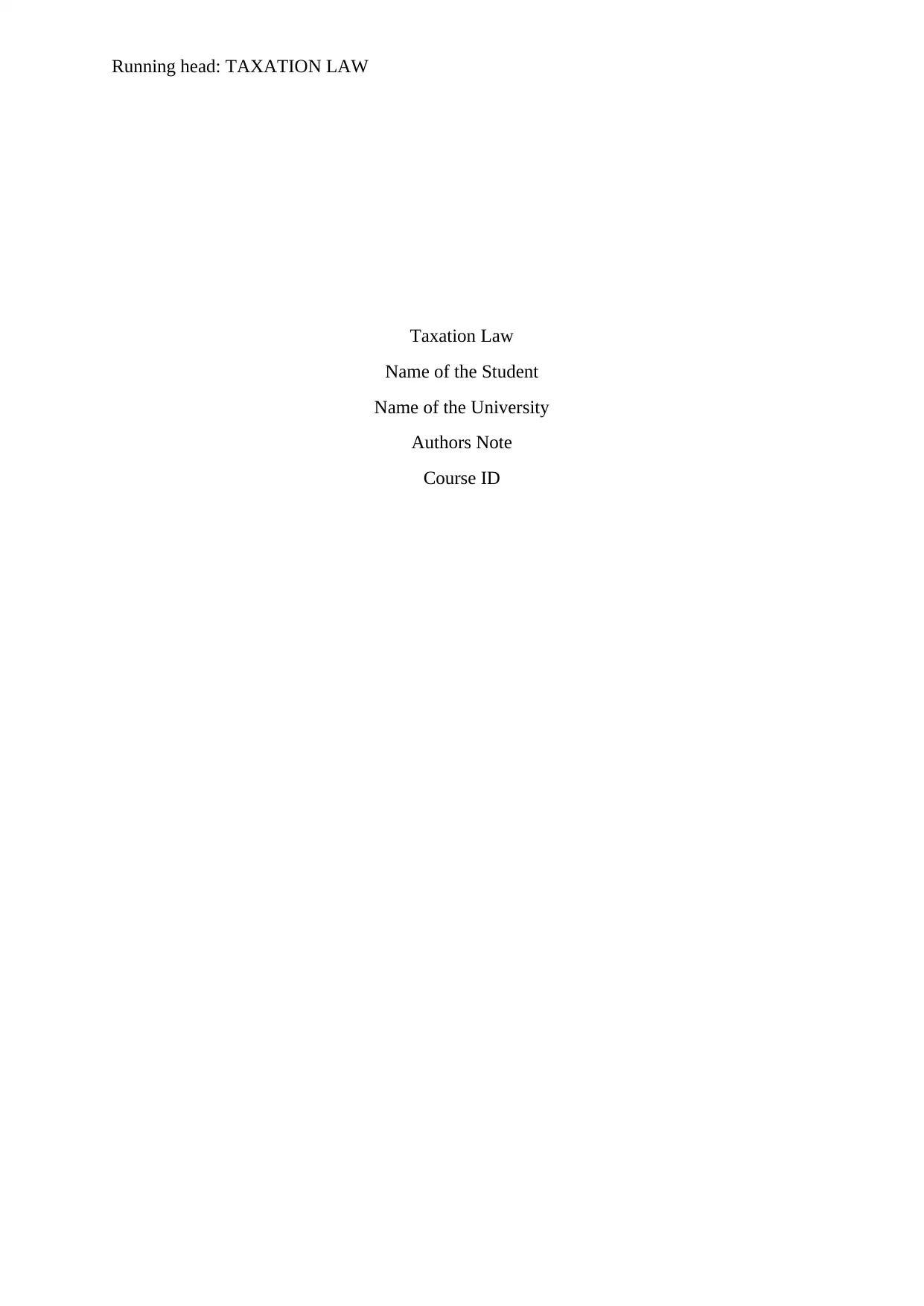
Running head: TAXATION LAW
Taxation Law
Name of the Student
Name of the University
Authors Note
Course ID
Taxation Law
Name of the Student
Name of the University
Authors Note
Course ID
Paraphrase This Document
Need a fresh take? Get an instant paraphrase of this document with our AI Paraphraser
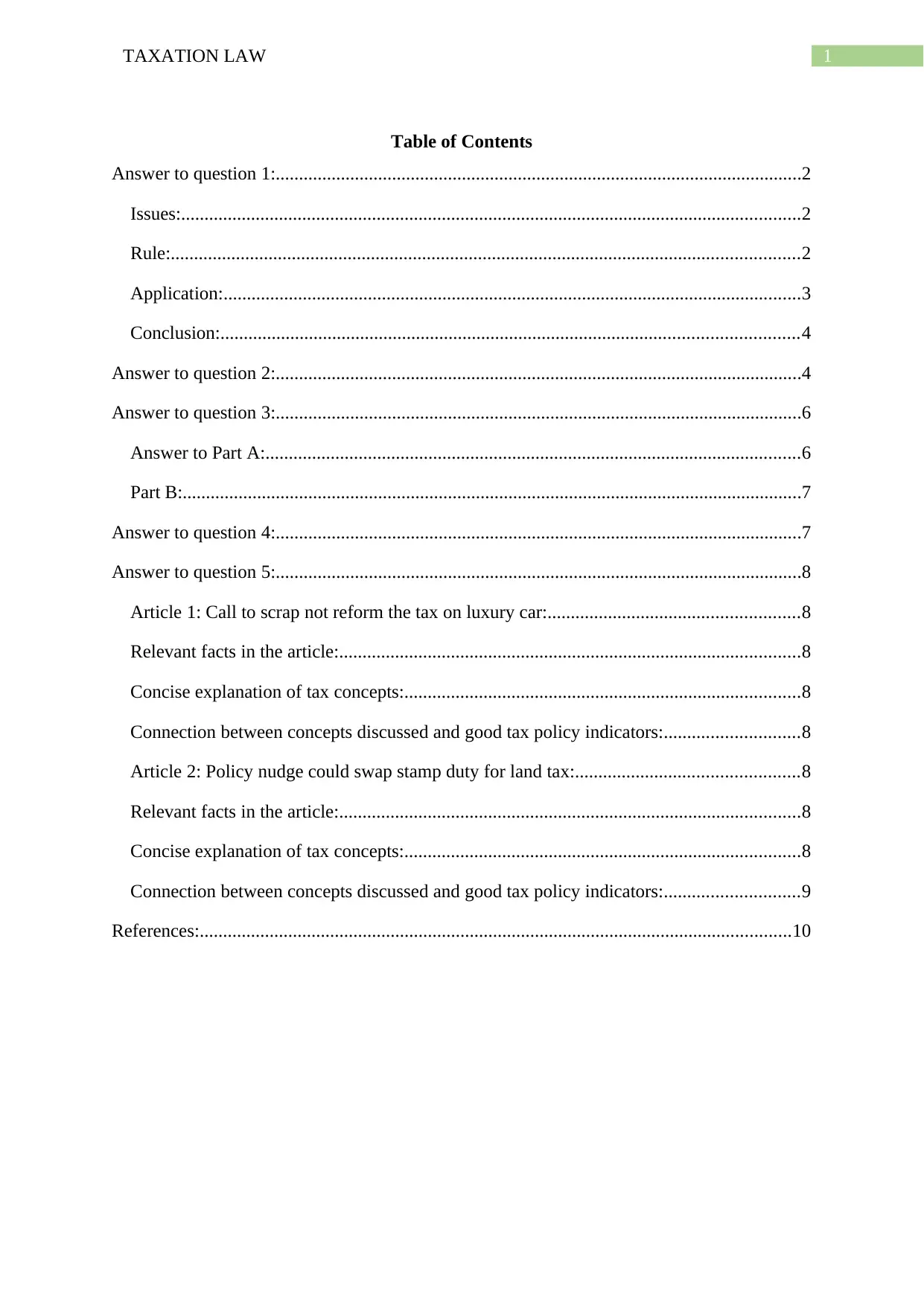
1TAXATION LAW
Table of Contents
Answer to question 1:.................................................................................................................2
Issues:.....................................................................................................................................2
Rule:.......................................................................................................................................2
Application:............................................................................................................................3
Conclusion:............................................................................................................................4
Answer to question 2:.................................................................................................................4
Answer to question 3:.................................................................................................................6
Answer to Part A:...................................................................................................................6
Part B:.....................................................................................................................................7
Answer to question 4:.................................................................................................................7
Answer to question 5:.................................................................................................................8
Article 1: Call to scrap not reform the tax on luxury car:......................................................8
Relevant facts in the article:...................................................................................................8
Concise explanation of tax concepts:.....................................................................................8
Connection between concepts discussed and good tax policy indicators:.............................8
Article 2: Policy nudge could swap stamp duty for land tax:................................................8
Relevant facts in the article:...................................................................................................8
Concise explanation of tax concepts:.....................................................................................8
Connection between concepts discussed and good tax policy indicators:.............................9
References:...............................................................................................................................10
Table of Contents
Answer to question 1:.................................................................................................................2
Issues:.....................................................................................................................................2
Rule:.......................................................................................................................................2
Application:............................................................................................................................3
Conclusion:............................................................................................................................4
Answer to question 2:.................................................................................................................4
Answer to question 3:.................................................................................................................6
Answer to Part A:...................................................................................................................6
Part B:.....................................................................................................................................7
Answer to question 4:.................................................................................................................7
Answer to question 5:.................................................................................................................8
Article 1: Call to scrap not reform the tax on luxury car:......................................................8
Relevant facts in the article:...................................................................................................8
Concise explanation of tax concepts:.....................................................................................8
Connection between concepts discussed and good tax policy indicators:.............................8
Article 2: Policy nudge could swap stamp duty for land tax:................................................8
Relevant facts in the article:...................................................................................................8
Concise explanation of tax concepts:.....................................................................................8
Connection between concepts discussed and good tax policy indicators:.............................9
References:...............................................................................................................................10
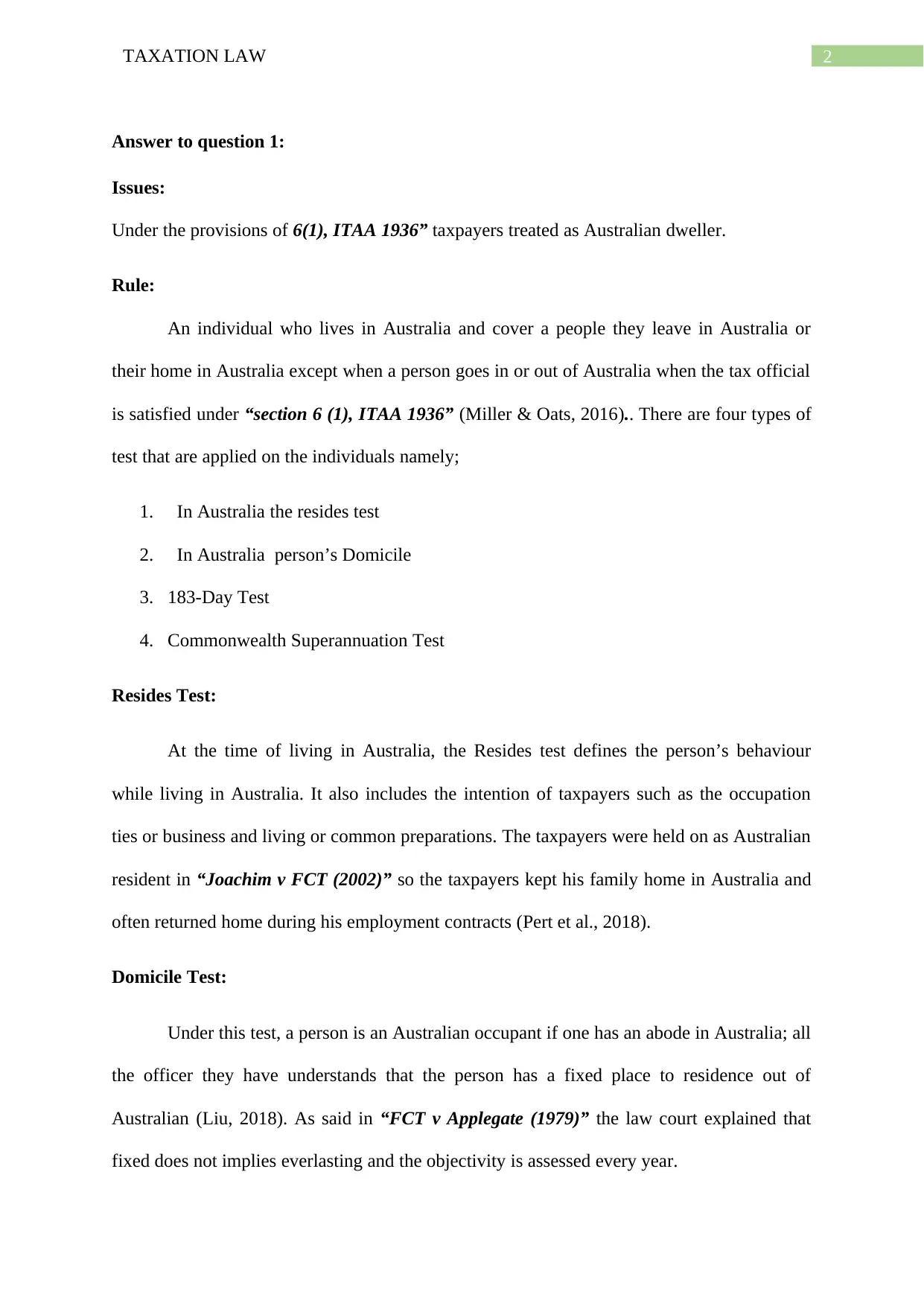
2TAXATION LAW
Answer to question 1:
Issues:
Under the provisions of 6(1), ITAA 1936” taxpayers treated as Australian dweller.
Rule:
An individual who lives in Australia and cover a people they leave in Australia or
their home in Australia except when a person goes in or out of Australia when the tax official
is satisfied under “section 6 (1), ITAA 1936” (Miller & Oats, 2016).. There are four types of
test that are applied on the individuals namely;
1. In Australia the resides test
2. In Australia person’s Domicile
3. 183-Day Test
4. Commonwealth Superannuation Test
Resides Test:
At the time of living in Australia, the Resides test defines the person’s behaviour
while living in Australia. It also includes the intention of taxpayers such as the occupation
ties or business and living or common preparations. The taxpayers were held on as Australian
resident in “Joachim v FCT (2002)” so the taxpayers kept his family home in Australia and
often returned home during his employment contracts (Pert et al., 2018).
Domicile Test:
Under this test, a person is an Australian occupant if one has an abode in Australia; all
the officer they have understands that the person has a fixed place to residence out of
Australian (Liu, 2018). As said in “FCT v Applegate (1979)” the law court explained that
fixed does not implies everlasting and the objectivity is assessed every year.
Answer to question 1:
Issues:
Under the provisions of 6(1), ITAA 1936” taxpayers treated as Australian dweller.
Rule:
An individual who lives in Australia and cover a people they leave in Australia or
their home in Australia except when a person goes in or out of Australia when the tax official
is satisfied under “section 6 (1), ITAA 1936” (Miller & Oats, 2016).. There are four types of
test that are applied on the individuals namely;
1. In Australia the resides test
2. In Australia person’s Domicile
3. 183-Day Test
4. Commonwealth Superannuation Test
Resides Test:
At the time of living in Australia, the Resides test defines the person’s behaviour
while living in Australia. It also includes the intention of taxpayers such as the occupation
ties or business and living or common preparations. The taxpayers were held on as Australian
resident in “Joachim v FCT (2002)” so the taxpayers kept his family home in Australia and
often returned home during his employment contracts (Pert et al., 2018).
Domicile Test:
Under this test, a person is an Australian occupant if one has an abode in Australia; all
the officer they have understands that the person has a fixed place to residence out of
Australian (Liu, 2018). As said in “FCT v Applegate (1979)” the law court explained that
fixed does not implies everlasting and the objectivity is assessed every year.
⊘ This is a preview!⊘
Do you want full access?
Subscribe today to unlock all pages.

Trusted by 1+ million students worldwide
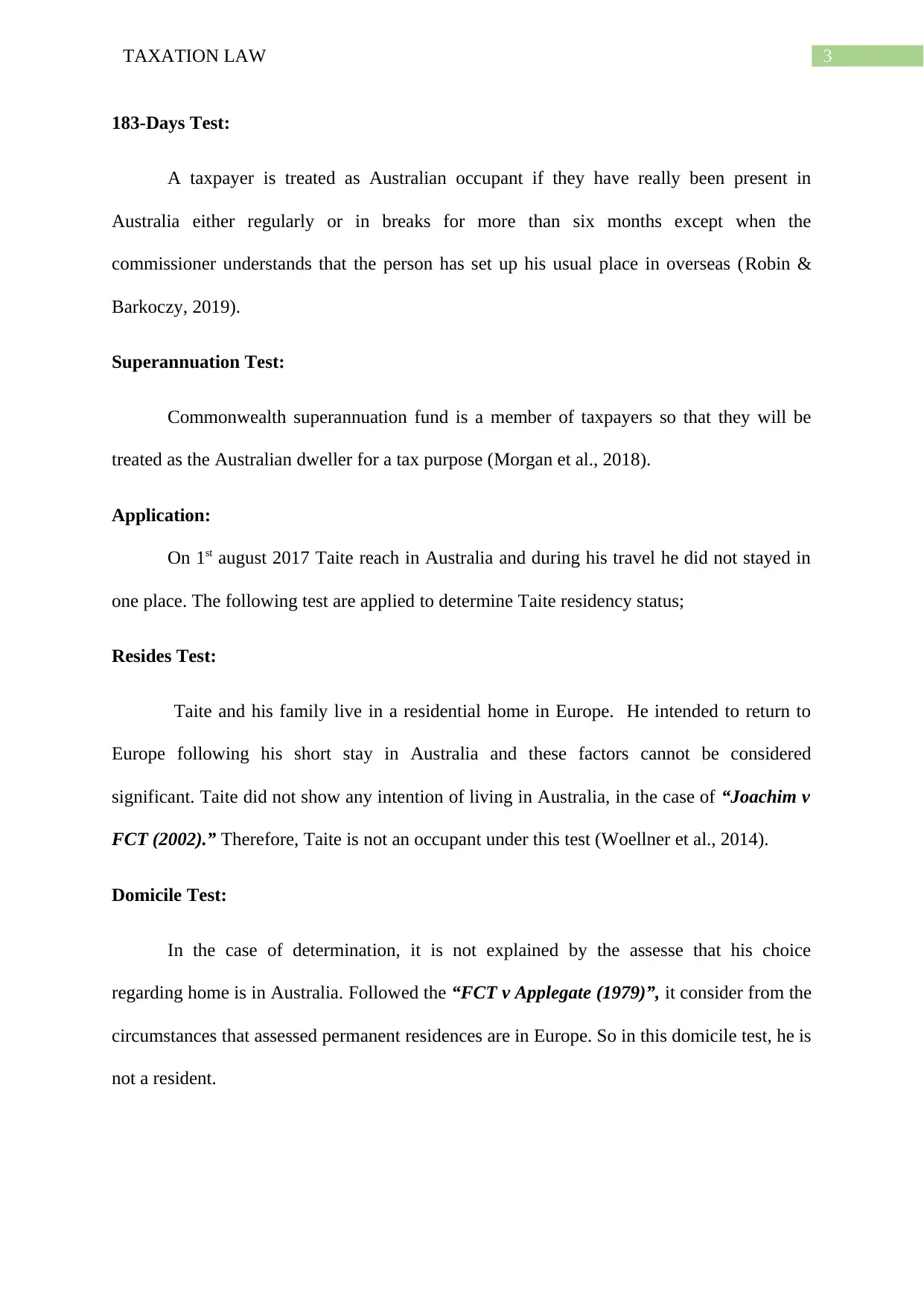
3TAXATION LAW
183-Days Test:
A taxpayer is treated as Australian occupant if they have really been present in
Australia either regularly or in breaks for more than six months except when the
commissioner understands that the person has set up his usual place in overseas (Robin &
Barkoczy, 2019).
Superannuation Test:
Commonwealth superannuation fund is a member of taxpayers so that they will be
treated as the Australian dweller for a tax purpose (Morgan et al., 2018).
Application:
On 1st august 2017 Taite reach in Australia and during his travel he did not stayed in
one place. The following test are applied to determine Taite residency status;
Resides Test:
Taite and his family live in a residential home in Europe. He intended to return to
Europe following his short stay in Australia and these factors cannot be considered
significant. Taite did not show any intention of living in Australia, in the case of “Joachim v
FCT (2002).” Therefore, Taite is not an occupant under this test (Woellner et al., 2014).
Domicile Test:
In the case of determination, it is not explained by the assesse that his choice
regarding home is in Australia. Followed the “FCT v Applegate (1979)”, it consider from the
circumstances that assessed permanent residences are in Europe. So in this domicile test, he is
not a resident.
183-Days Test:
A taxpayer is treated as Australian occupant if they have really been present in
Australia either regularly or in breaks for more than six months except when the
commissioner understands that the person has set up his usual place in overseas (Robin &
Barkoczy, 2019).
Superannuation Test:
Commonwealth superannuation fund is a member of taxpayers so that they will be
treated as the Australian dweller for a tax purpose (Morgan et al., 2018).
Application:
On 1st august 2017 Taite reach in Australia and during his travel he did not stayed in
one place. The following test are applied to determine Taite residency status;
Resides Test:
Taite and his family live in a residential home in Europe. He intended to return to
Europe following his short stay in Australia and these factors cannot be considered
significant. Taite did not show any intention of living in Australia, in the case of “Joachim v
FCT (2002).” Therefore, Taite is not an occupant under this test (Woellner et al., 2014).
Domicile Test:
In the case of determination, it is not explained by the assesse that his choice
regarding home is in Australia. Followed the “FCT v Applegate (1979)”, it consider from the
circumstances that assessed permanent residences are in Europe. So in this domicile test, he is
not a resident.
Paraphrase This Document
Need a fresh take? Get an instant paraphrase of this document with our AI Paraphraser
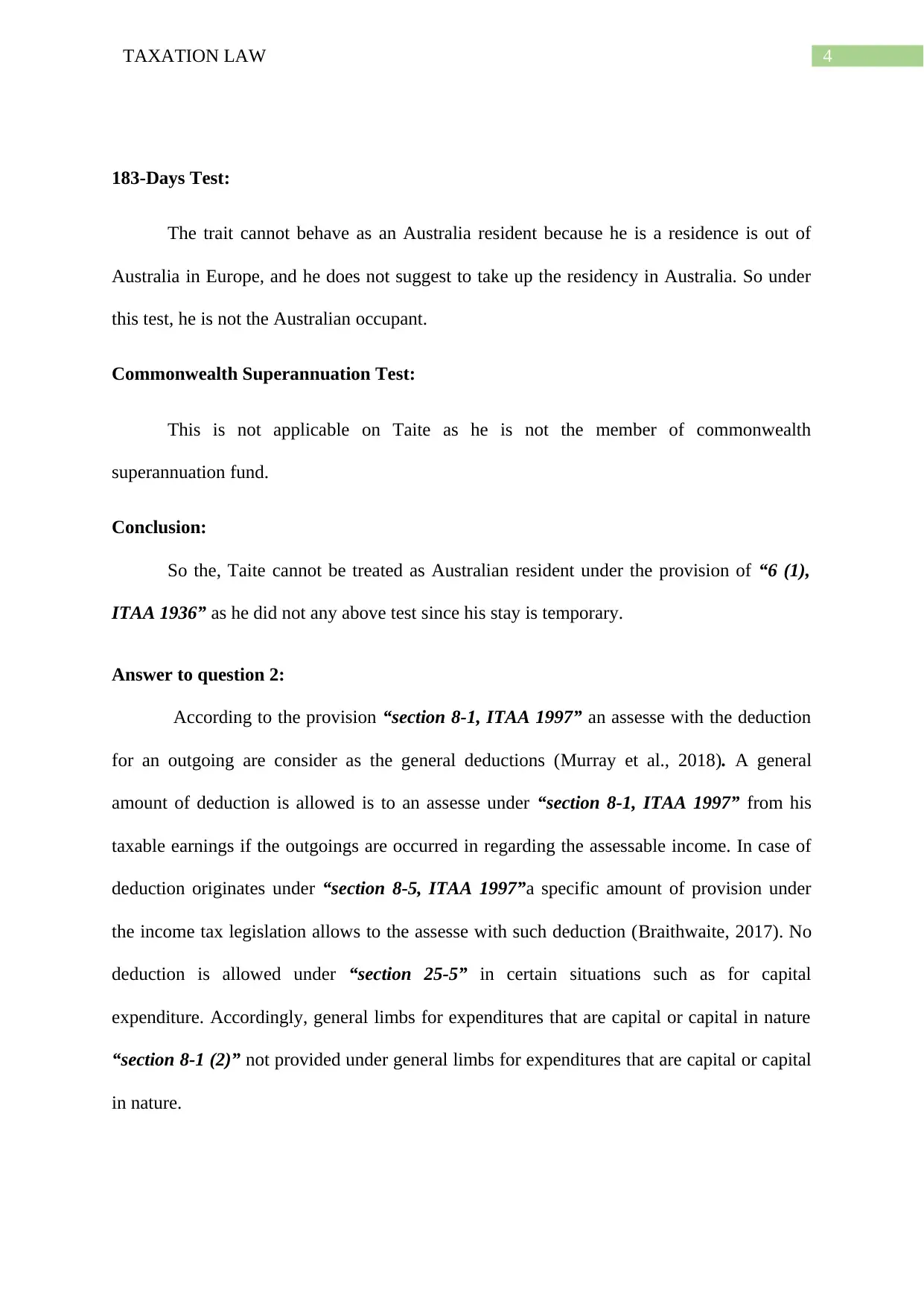
4TAXATION LAW
183-Days Test:
The trait cannot behave as an Australia resident because he is a residence is out of
Australia in Europe, and he does not suggest to take up the residency in Australia. So under
this test, he is not the Australian occupant.
Commonwealth Superannuation Test:
This is not applicable on Taite as he is not the member of commonwealth
superannuation fund.
Conclusion:
So the, Taite cannot be treated as Australian resident under the provision of “6 (1),
ITAA 1936” as he did not any above test since his stay is temporary.
Answer to question 2:
According to the provision “section 8-1, ITAA 1997” an assesse with the deduction
for an outgoing are consider as the general deductions (Murray et al., 2018). A general
amount of deduction is allowed is to an assesse under “section 8-1, ITAA 1997” from his
taxable earnings if the outgoings are occurred in regarding the assessable income. In case of
deduction originates under “section 8-5, ITAA 1997”a specific amount of provision under
the income tax legislation allows to the assesse with such deduction (Braithwaite, 2017). No
deduction is allowed under “section 25-5” in certain situations such as for capital
expenditure. Accordingly, general limbs for expenditures that are capital or capital in nature
“section 8-1 (2)” not provided under general limbs for expenditures that are capital or capital
in nature.
183-Days Test:
The trait cannot behave as an Australia resident because he is a residence is out of
Australia in Europe, and he does not suggest to take up the residency in Australia. So under
this test, he is not the Australian occupant.
Commonwealth Superannuation Test:
This is not applicable on Taite as he is not the member of commonwealth
superannuation fund.
Conclusion:
So the, Taite cannot be treated as Australian resident under the provision of “6 (1),
ITAA 1936” as he did not any above test since his stay is temporary.
Answer to question 2:
According to the provision “section 8-1, ITAA 1997” an assesse with the deduction
for an outgoing are consider as the general deductions (Murray et al., 2018). A general
amount of deduction is allowed is to an assesse under “section 8-1, ITAA 1997” from his
taxable earnings if the outgoings are occurred in regarding the assessable income. In case of
deduction originates under “section 8-5, ITAA 1997”a specific amount of provision under
the income tax legislation allows to the assesse with such deduction (Braithwaite, 2017). No
deduction is allowed under “section 25-5” in certain situations such as for capital
expenditure. Accordingly, general limbs for expenditures that are capital or capital in nature
“section 8-1 (2)” not provided under general limbs for expenditures that are capital or capital
in nature.
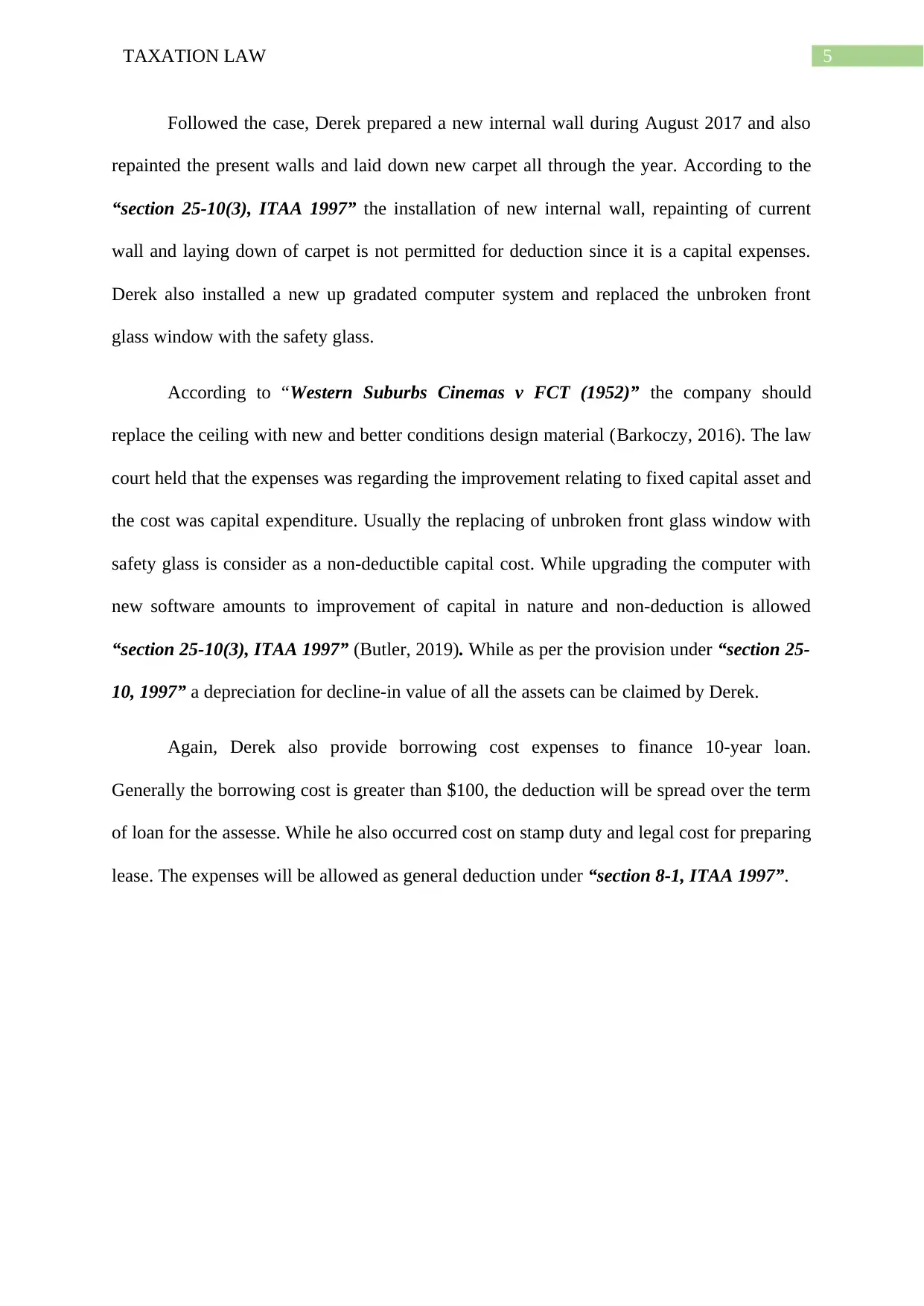
5TAXATION LAW
Followed the case, Derek prepared a new internal wall during August 2017 and also
repainted the present walls and laid down new carpet all through the year. According to the
“section 25-10(3), ITAA 1997” the installation of new internal wall, repainting of current
wall and laying down of carpet is not permitted for deduction since it is a capital expenses.
Derek also installed a new up gradated computer system and replaced the unbroken front
glass window with the safety glass.
According to “Western Suburbs Cinemas v FCT (1952)” the company should
replace the ceiling with new and better conditions design material (Barkoczy, 2016). The law
court held that the expenses was regarding the improvement relating to fixed capital asset and
the cost was capital expenditure. Usually the replacing of unbroken front glass window with
safety glass is consider as a non-deductible capital cost. While upgrading the computer with
new software amounts to improvement of capital in nature and non-deduction is allowed
“section 25-10(3), ITAA 1997” (Butler, 2019). While as per the provision under “section 25-
10, 1997” a depreciation for decline-in value of all the assets can be claimed by Derek.
Again, Derek also provide borrowing cost expenses to finance 10-year loan.
Generally the borrowing cost is greater than $100, the deduction will be spread over the term
of loan for the assesse. While he also occurred cost on stamp duty and legal cost for preparing
lease. The expenses will be allowed as general deduction under “section 8-1, ITAA 1997”.
Followed the case, Derek prepared a new internal wall during August 2017 and also
repainted the present walls and laid down new carpet all through the year. According to the
“section 25-10(3), ITAA 1997” the installation of new internal wall, repainting of current
wall and laying down of carpet is not permitted for deduction since it is a capital expenses.
Derek also installed a new up gradated computer system and replaced the unbroken front
glass window with the safety glass.
According to “Western Suburbs Cinemas v FCT (1952)” the company should
replace the ceiling with new and better conditions design material (Barkoczy, 2016). The law
court held that the expenses was regarding the improvement relating to fixed capital asset and
the cost was capital expenditure. Usually the replacing of unbroken front glass window with
safety glass is consider as a non-deductible capital cost. While upgrading the computer with
new software amounts to improvement of capital in nature and non-deduction is allowed
“section 25-10(3), ITAA 1997” (Butler, 2019). While as per the provision under “section 25-
10, 1997” a depreciation for decline-in value of all the assets can be claimed by Derek.
Again, Derek also provide borrowing cost expenses to finance 10-year loan.
Generally the borrowing cost is greater than $100, the deduction will be spread over the term
of loan for the assesse. While he also occurred cost on stamp duty and legal cost for preparing
lease. The expenses will be allowed as general deduction under “section 8-1, ITAA 1997”.
⊘ This is a preview!⊘
Do you want full access?
Subscribe today to unlock all pages.

Trusted by 1+ million students worldwide
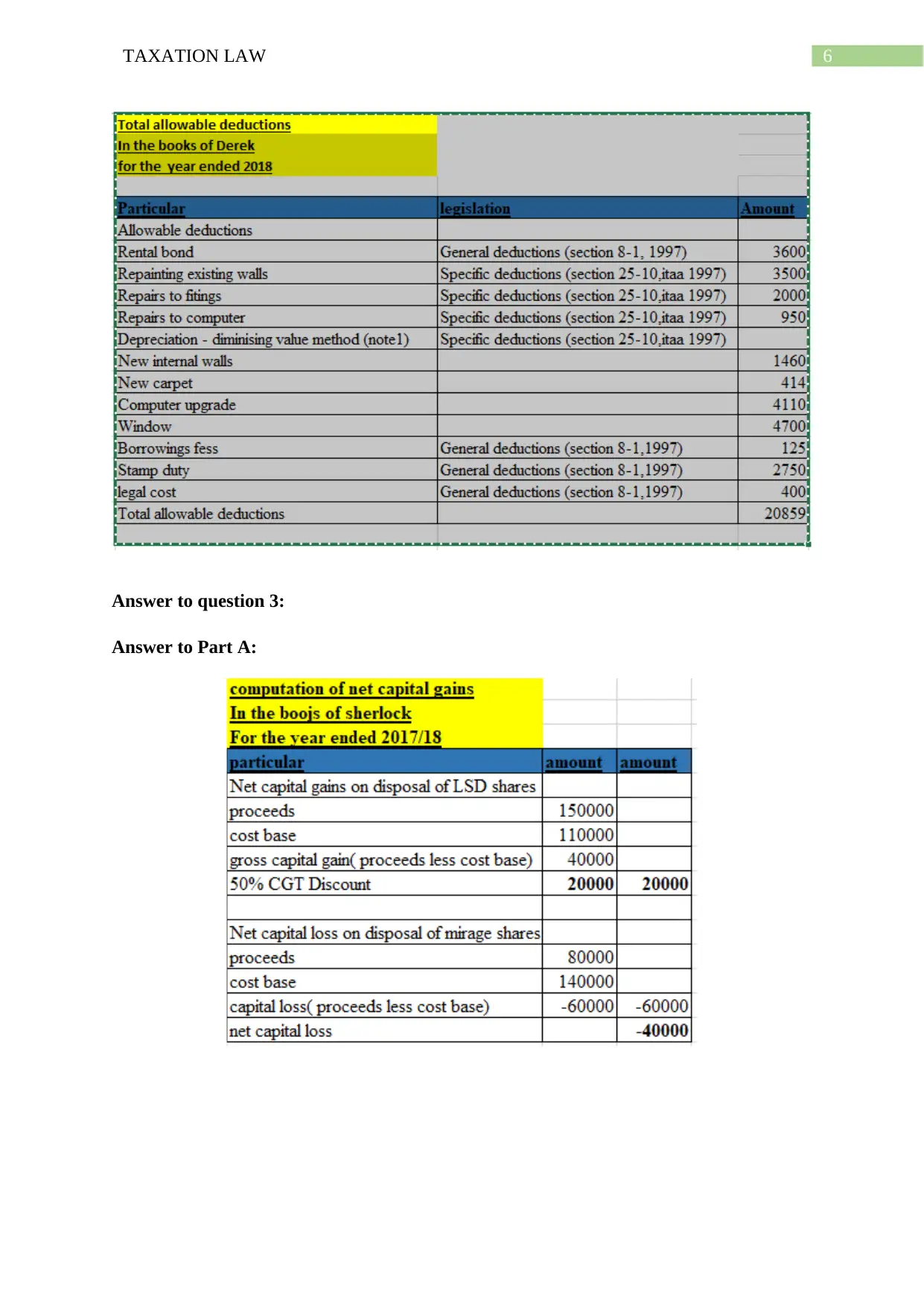
6TAXATION LAW
Answer to question 3:
Answer to Part A:
Answer to question 3:
Answer to Part A:
Paraphrase This Document
Need a fresh take? Get an instant paraphrase of this document with our AI Paraphraser
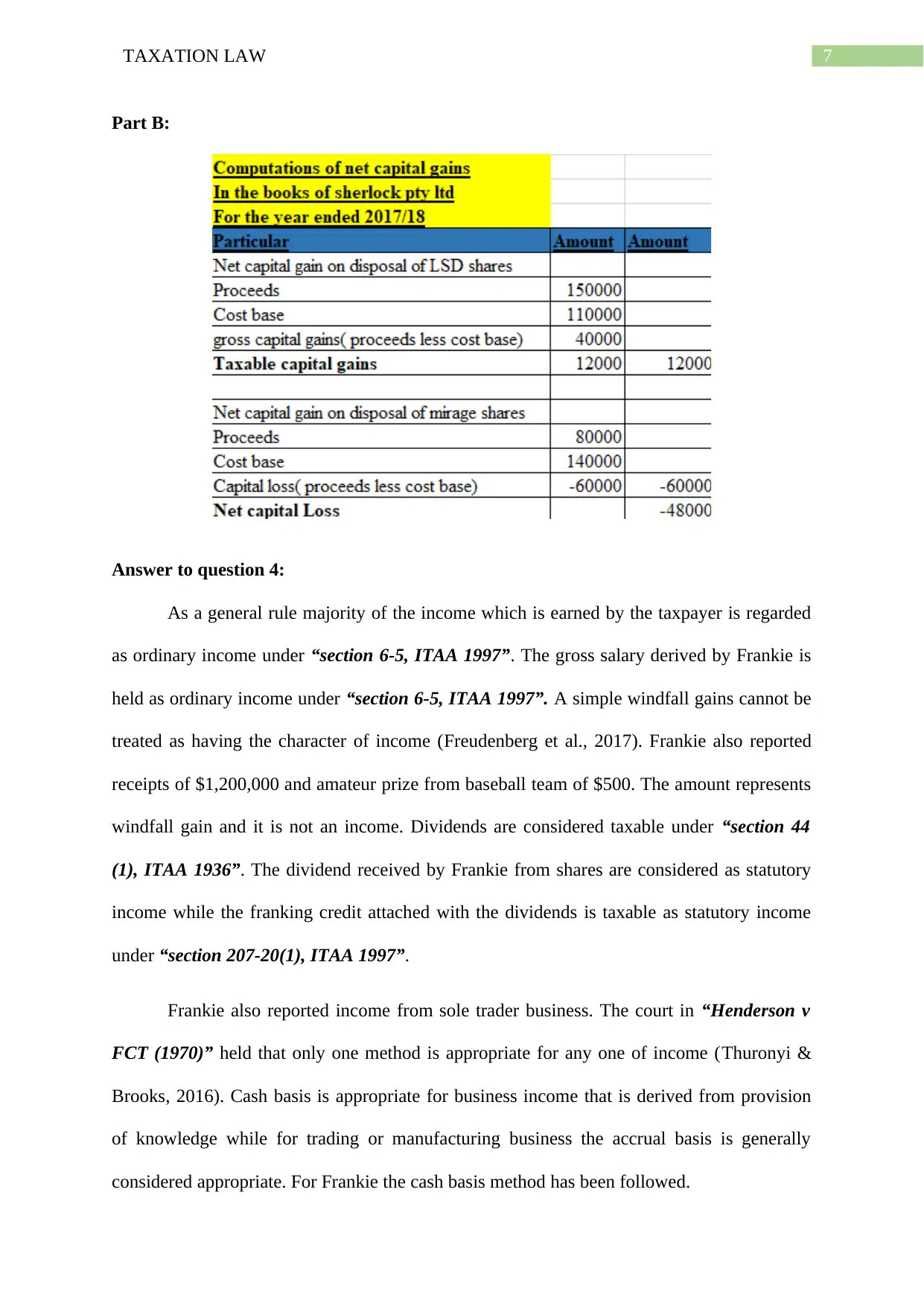
7TAXATION LAW
Part B:
Answer to question 4:
As a general rule majority of the income which is earned by the taxpayer is regarded
as ordinary income under “section 6-5, ITAA 1997”. The gross salary derived by Frankie is
held as ordinary income under “section 6-5, ITAA 1997”. A simple windfall gains cannot be
treated as having the character of income (Freudenberg et al., 2017). Frankie also reported
receipts of $1,200,000 and amateur prize from baseball team of $500. The amount represents
windfall gain and it is not an income. Dividends are considered taxable under “section 44
(1), ITAA 1936”. The dividend received by Frankie from shares are considered as statutory
income while the franking credit attached with the dividends is taxable as statutory income
under “section 207-20(1), ITAA 1997”.
Frankie also reported income from sole trader business. The court in “Henderson v
FCT (1970)” held that only one method is appropriate for any one of income (Thuronyi &
Brooks, 2016). Cash basis is appropriate for business income that is derived from provision
of knowledge while for trading or manufacturing business the accrual basis is generally
considered appropriate. For Frankie the cash basis method has been followed.
Part B:
Answer to question 4:
As a general rule majority of the income which is earned by the taxpayer is regarded
as ordinary income under “section 6-5, ITAA 1997”. The gross salary derived by Frankie is
held as ordinary income under “section 6-5, ITAA 1997”. A simple windfall gains cannot be
treated as having the character of income (Freudenberg et al., 2017). Frankie also reported
receipts of $1,200,000 and amateur prize from baseball team of $500. The amount represents
windfall gain and it is not an income. Dividends are considered taxable under “section 44
(1), ITAA 1936”. The dividend received by Frankie from shares are considered as statutory
income while the franking credit attached with the dividends is taxable as statutory income
under “section 207-20(1), ITAA 1997”.
Frankie also reported income from sole trader business. The court in “Henderson v
FCT (1970)” held that only one method is appropriate for any one of income (Thuronyi &
Brooks, 2016). Cash basis is appropriate for business income that is derived from provision
of knowledge while for trading or manufacturing business the accrual basis is generally
considered appropriate. For Frankie the cash basis method has been followed.
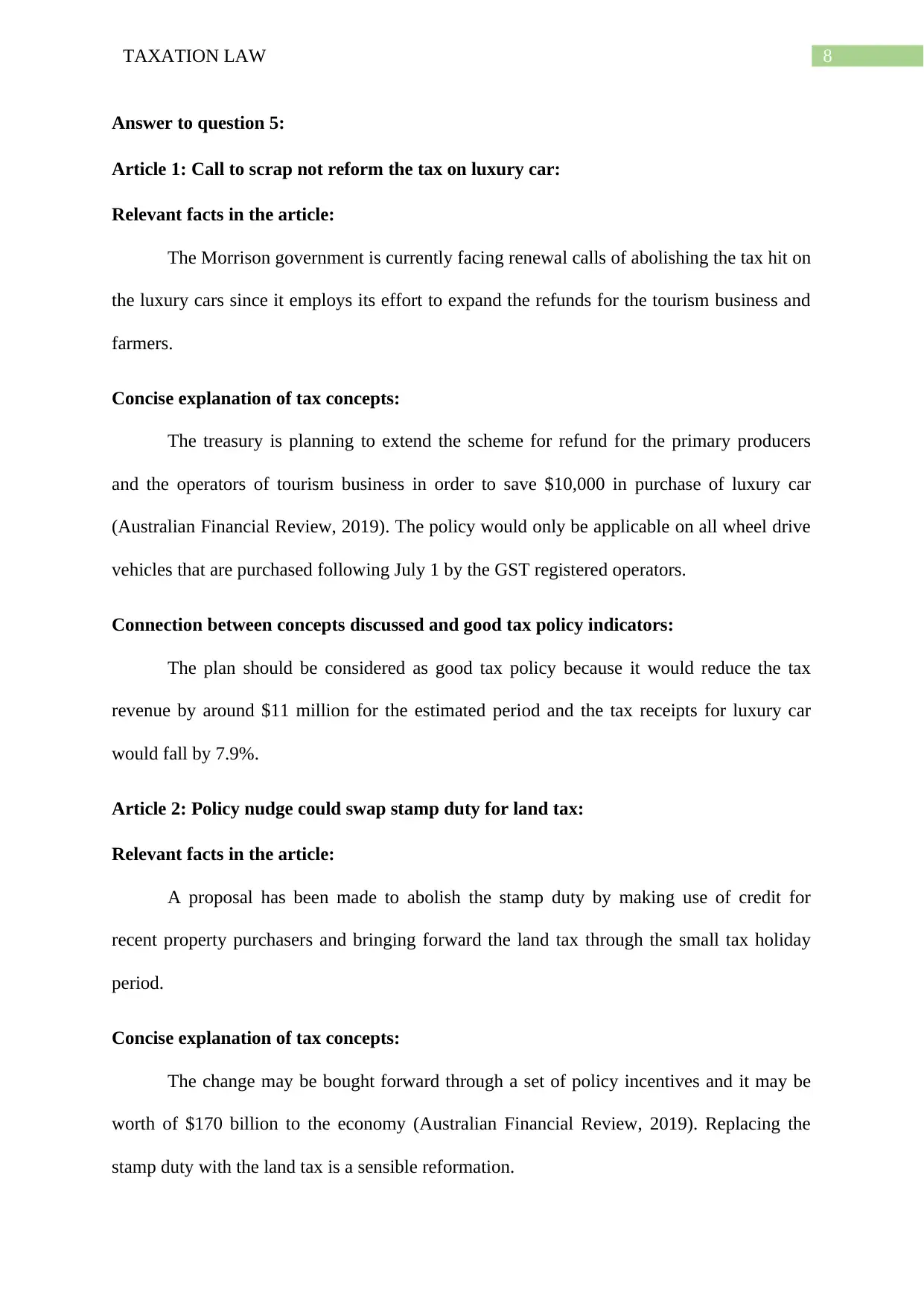
8TAXATION LAW
Answer to question 5:
Article 1: Call to scrap not reform the tax on luxury car:
Relevant facts in the article:
The Morrison government is currently facing renewal calls of abolishing the tax hit on
the luxury cars since it employs its effort to expand the refunds for the tourism business and
farmers.
Concise explanation of tax concepts:
The treasury is planning to extend the scheme for refund for the primary producers
and the operators of tourism business in order to save $10,000 in purchase of luxury car
(Australian Financial Review, 2019). The policy would only be applicable on all wheel drive
vehicles that are purchased following July 1 by the GST registered operators.
Connection between concepts discussed and good tax policy indicators:
The plan should be considered as good tax policy because it would reduce the tax
revenue by around $11 million for the estimated period and the tax receipts for luxury car
would fall by 7.9%.
Article 2: Policy nudge could swap stamp duty for land tax:
Relevant facts in the article:
A proposal has been made to abolish the stamp duty by making use of credit for
recent property purchasers and bringing forward the land tax through the small tax holiday
period.
Concise explanation of tax concepts:
The change may be bought forward through a set of policy incentives and it may be
worth of $170 billion to the economy (Australian Financial Review, 2019). Replacing the
stamp duty with the land tax is a sensible reformation.
Answer to question 5:
Article 1: Call to scrap not reform the tax on luxury car:
Relevant facts in the article:
The Morrison government is currently facing renewal calls of abolishing the tax hit on
the luxury cars since it employs its effort to expand the refunds for the tourism business and
farmers.
Concise explanation of tax concepts:
The treasury is planning to extend the scheme for refund for the primary producers
and the operators of tourism business in order to save $10,000 in purchase of luxury car
(Australian Financial Review, 2019). The policy would only be applicable on all wheel drive
vehicles that are purchased following July 1 by the GST registered operators.
Connection between concepts discussed and good tax policy indicators:
The plan should be considered as good tax policy because it would reduce the tax
revenue by around $11 million for the estimated period and the tax receipts for luxury car
would fall by 7.9%.
Article 2: Policy nudge could swap stamp duty for land tax:
Relevant facts in the article:
A proposal has been made to abolish the stamp duty by making use of credit for
recent property purchasers and bringing forward the land tax through the small tax holiday
period.
Concise explanation of tax concepts:
The change may be bought forward through a set of policy incentives and it may be
worth of $170 billion to the economy (Australian Financial Review, 2019). Replacing the
stamp duty with the land tax is a sensible reformation.
⊘ This is a preview!⊘
Do you want full access?
Subscribe today to unlock all pages.

Trusted by 1+ million students worldwide
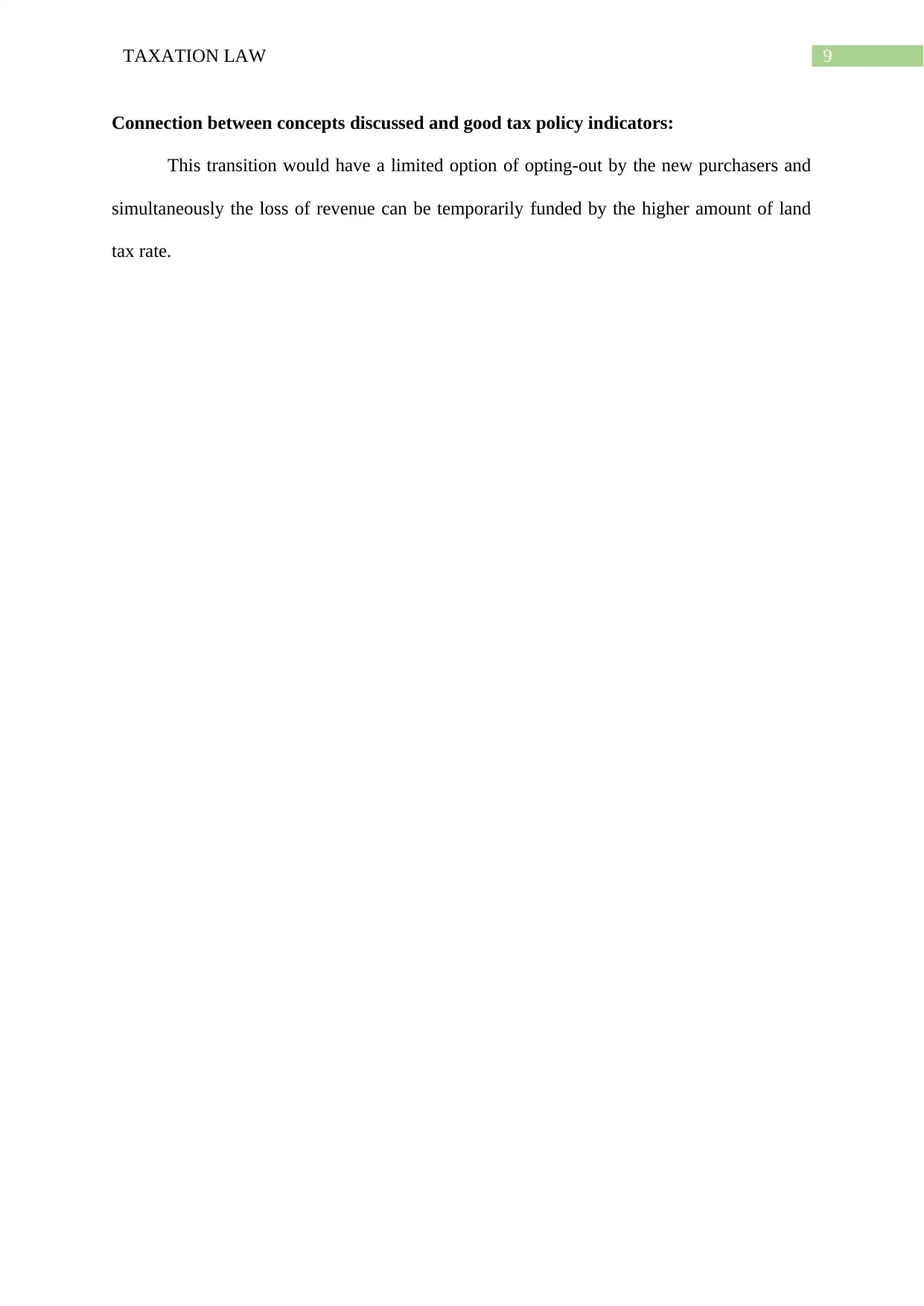
9TAXATION LAW
Connection between concepts discussed and good tax policy indicators:
This transition would have a limited option of opting-out by the new purchasers and
simultaneously the loss of revenue can be temporarily funded by the higher amount of land
tax rate.
Connection between concepts discussed and good tax policy indicators:
This transition would have a limited option of opting-out by the new purchasers and
simultaneously the loss of revenue can be temporarily funded by the higher amount of land
tax rate.
Paraphrase This Document
Need a fresh take? Get an instant paraphrase of this document with our AI Paraphraser
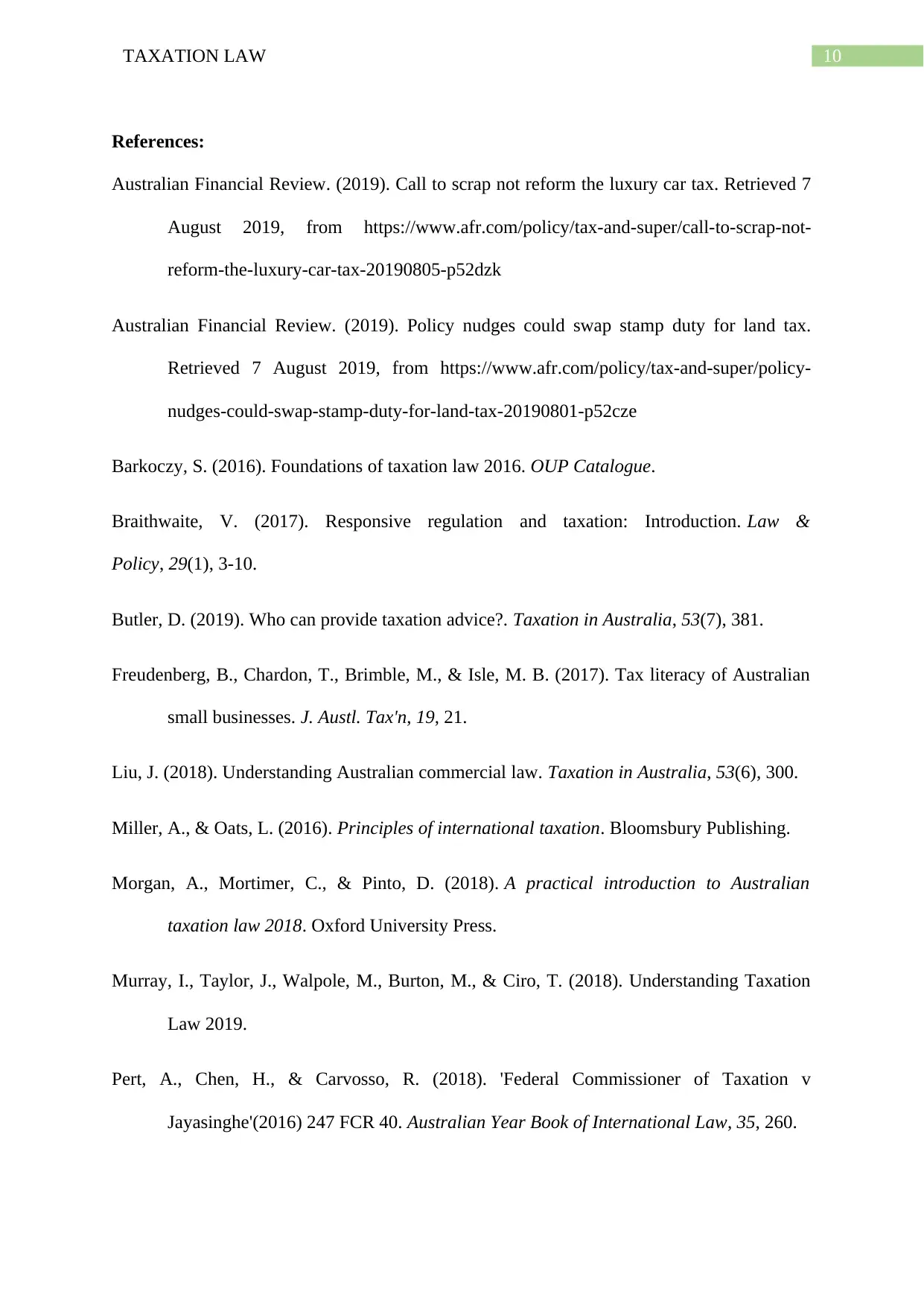
10TAXATION LAW
References:
Australian Financial Review. (2019). Call to scrap not reform the luxury car tax. Retrieved 7
August 2019, from https://www.afr.com/policy/tax-and-super/call-to-scrap-not-
reform-the-luxury-car-tax-20190805-p52dzk
Australian Financial Review. (2019). Policy nudges could swap stamp duty for land tax.
Retrieved 7 August 2019, from https://www.afr.com/policy/tax-and-super/policy-
nudges-could-swap-stamp-duty-for-land-tax-20190801-p52cze
Barkoczy, S. (2016). Foundations of taxation law 2016. OUP Catalogue.
Braithwaite, V. (2017). Responsive regulation and taxation: Introduction. Law &
Policy, 29(1), 3-10.
Butler, D. (2019). Who can provide taxation advice?. Taxation in Australia, 53(7), 381.
Freudenberg, B., Chardon, T., Brimble, M., & Isle, M. B. (2017). Tax literacy of Australian
small businesses. J. Austl. Tax'n, 19, 21.
Liu, J. (2018). Understanding Australian commercial law. Taxation in Australia, 53(6), 300.
Miller, A., & Oats, L. (2016). Principles of international taxation. Bloomsbury Publishing.
Morgan, A., Mortimer, C., & Pinto, D. (2018). A practical introduction to Australian
taxation law 2018. Oxford University Press.
Murray, I., Taylor, J., Walpole, M., Burton, M., & Ciro, T. (2018). Understanding Taxation
Law 2019.
Pert, A., Chen, H., & Carvosso, R. (2018). 'Federal Commissioner of Taxation v
Jayasinghe'(2016) 247 FCR 40. Australian Year Book of International Law, 35, 260.
References:
Australian Financial Review. (2019). Call to scrap not reform the luxury car tax. Retrieved 7
August 2019, from https://www.afr.com/policy/tax-and-super/call-to-scrap-not-
reform-the-luxury-car-tax-20190805-p52dzk
Australian Financial Review. (2019). Policy nudges could swap stamp duty for land tax.
Retrieved 7 August 2019, from https://www.afr.com/policy/tax-and-super/policy-
nudges-could-swap-stamp-duty-for-land-tax-20190801-p52cze
Barkoczy, S. (2016). Foundations of taxation law 2016. OUP Catalogue.
Braithwaite, V. (2017). Responsive regulation and taxation: Introduction. Law &
Policy, 29(1), 3-10.
Butler, D. (2019). Who can provide taxation advice?. Taxation in Australia, 53(7), 381.
Freudenberg, B., Chardon, T., Brimble, M., & Isle, M. B. (2017). Tax literacy of Australian
small businesses. J. Austl. Tax'n, 19, 21.
Liu, J. (2018). Understanding Australian commercial law. Taxation in Australia, 53(6), 300.
Miller, A., & Oats, L. (2016). Principles of international taxation. Bloomsbury Publishing.
Morgan, A., Mortimer, C., & Pinto, D. (2018). A practical introduction to Australian
taxation law 2018. Oxford University Press.
Murray, I., Taylor, J., Walpole, M., Burton, M., & Ciro, T. (2018). Understanding Taxation
Law 2019.
Pert, A., Chen, H., & Carvosso, R. (2018). 'Federal Commissioner of Taxation v
Jayasinghe'(2016) 247 FCR 40. Australian Year Book of International Law, 35, 260.
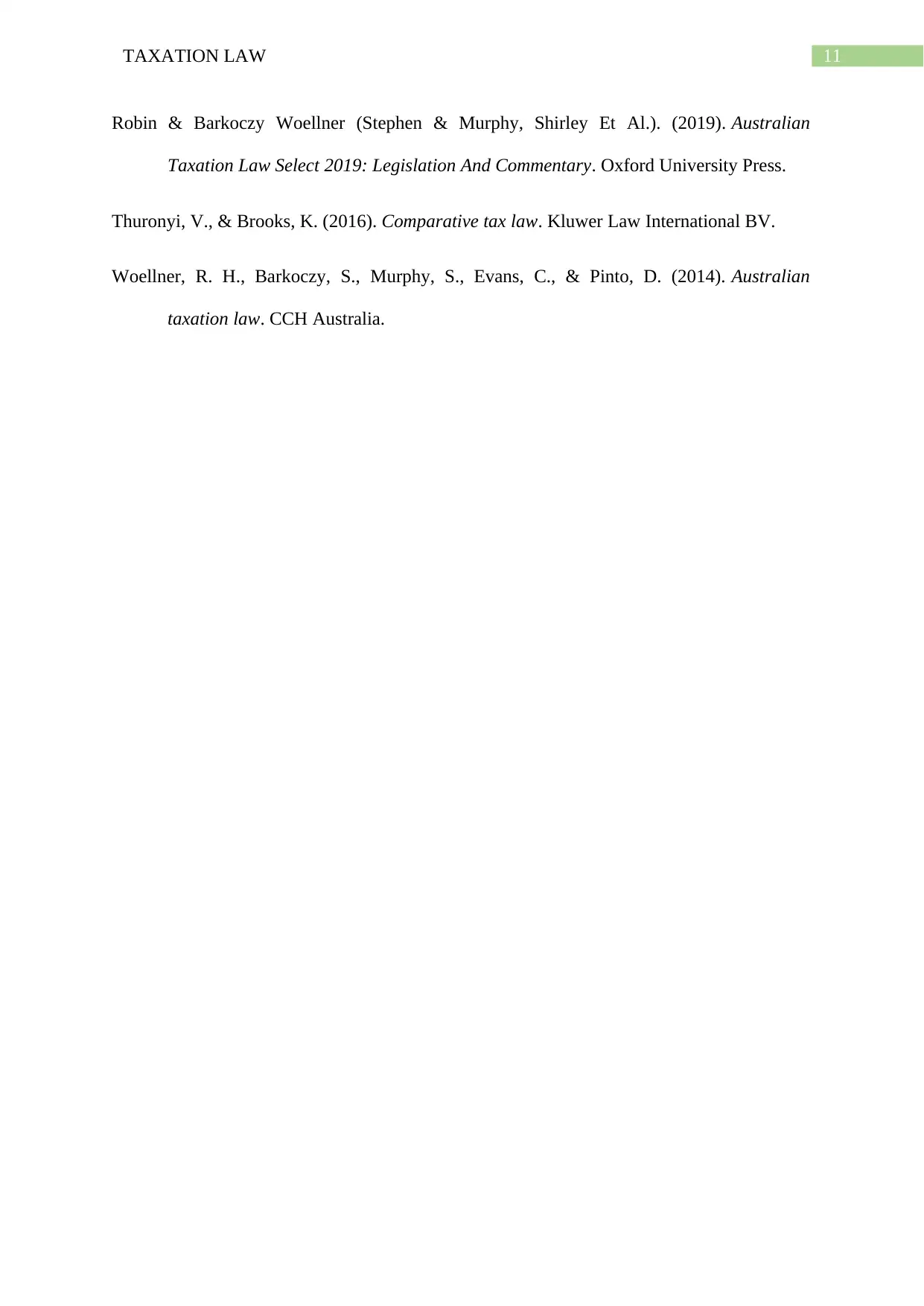
11TAXATION LAW
Robin & Barkoczy Woellner (Stephen & Murphy, Shirley Et Al.). (2019). Australian
Taxation Law Select 2019: Legislation And Commentary. Oxford University Press.
Thuronyi, V., & Brooks, K. (2016). Comparative tax law. Kluwer Law International BV.
Woellner, R. H., Barkoczy, S., Murphy, S., Evans, C., & Pinto, D. (2014). Australian
taxation law. CCH Australia.
Robin & Barkoczy Woellner (Stephen & Murphy, Shirley Et Al.). (2019). Australian
Taxation Law Select 2019: Legislation And Commentary. Oxford University Press.
Thuronyi, V., & Brooks, K. (2016). Comparative tax law. Kluwer Law International BV.
Woellner, R. H., Barkoczy, S., Murphy, S., Evans, C., & Pinto, D. (2014). Australian
taxation law. CCH Australia.
⊘ This is a preview!⊘
Do you want full access?
Subscribe today to unlock all pages.

Trusted by 1+ million students worldwide
1 out of 12
Related Documents
Your All-in-One AI-Powered Toolkit for Academic Success.
+13062052269
info@desklib.com
Available 24*7 on WhatsApp / Email
![[object Object]](/_next/static/media/star-bottom.7253800d.svg)
Unlock your academic potential
Copyright © 2020–2025 A2Z Services. All Rights Reserved. Developed and managed by ZUCOL.





